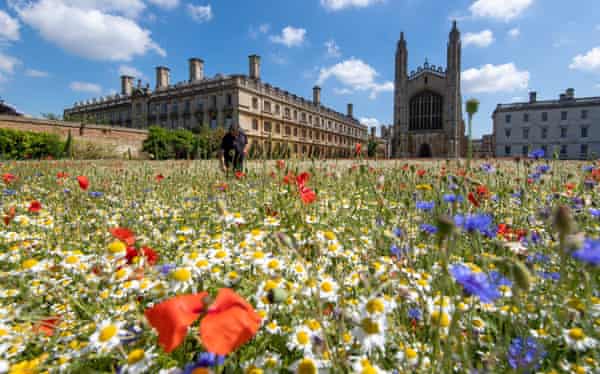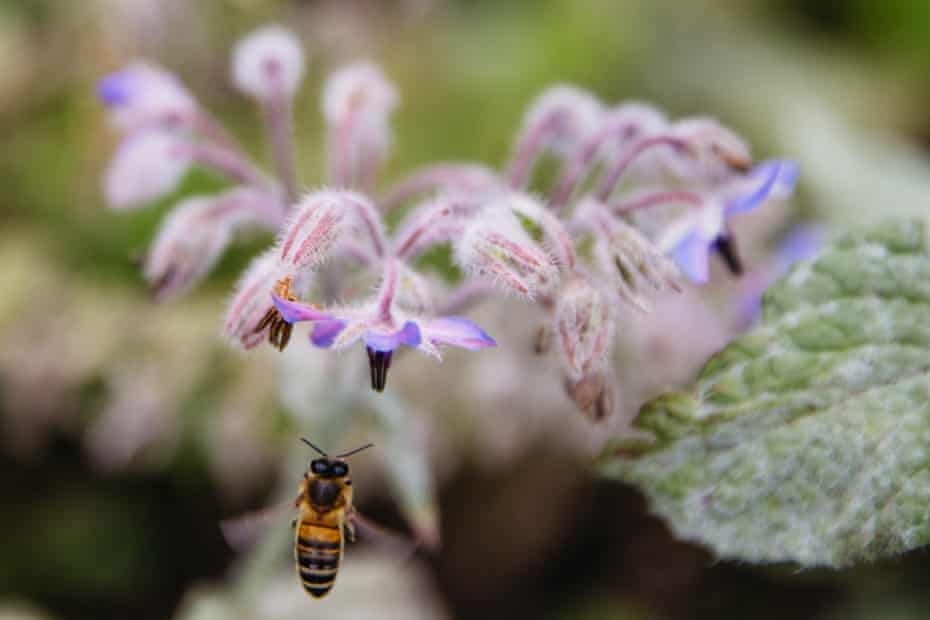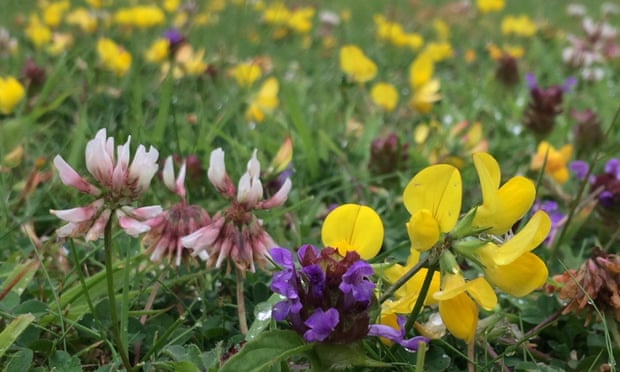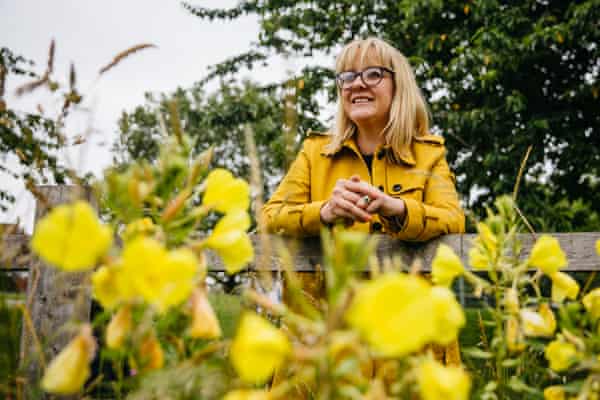Went to mow … but stopped: how UK cities embraced the meadows revolution

From Peckham to Plymouth, wildflowers are thriving in urban areas as councils let the grass grow to create ‘managed messiness’ for wildlife to thrive
Last modified on Sat 10 Jul 2021 23.37 EDT
A patch of purple wildflowers springs out of Peckham Rye like a bruise. Elsewhere, strips of long grass quiver in the wind, breaking up the uniformity of well-cut grass. Poppies, red campion and meadowsweet are among spring’s colourful arrivals.
Since May, London’s Southwark council has mowed a third less grass than it normally does and these flowers sprouted by themselves from seeds that had lain dormant in the earth. It is the latest addition to Southwark council’s flower-rich grasslands that have been extended by seven hectares (17 acres) since 1994.

All over the country, city councils are letting well-manicured grass grow out to create messier spaces for wildlife. Even some Oxbridge colleges are turning their famous lawns into wildflower meadows.
Fantastic diversity is lying dormant within our soils, particularly in London parks that have been protected from development for hundreds of years. Many seeds have been waiting underground for decades (a poppy seed can survive for 70 years waiting to germinate) and the eruption of colour shows wildflowers belong in cities just as much as the countryside.
“We were just going to see what came up and it’s been much better than we expected,” says Southwark council parks manager Will Walpole. “Peckham Rye common is ancient, nothing significant has been built on it. A lot of these native plants will put seed down and they’ll last for a very long time.”
Peckham Rye common was bought by London county council in 1868 and has been maintained as a place for local residents to share ever since. Now people come to play football or use the cricket nets, but in the past collecting herbal remedies would have been part of everyday life.

Lady’s bedstraw (which is doing particularly well by the Round cafe in the middle of the park) would have been used to stuff mattresses and pillows, while its yellow flowers coloured cheese and butter. Red campion was used as a remedy for snakebite, and meadowsweet to treat a variety of illnesses from colds to joint disorders.
The old-fashioned approach to meadow management has many benefits, such as reduced carbon output from less mowing and a slight budget saving for the council. But the main reason is that the obsession for well-cut grass harms biodiversity. People increasingly understand the need to share our cities with wildlife.
“I think if we decided to do this maybe five to 10 years ago I would have had an inbox full of complaints about how we didn’t cut the grass. We didn’t get that this year,” says Walpole. “I think public opinion has moved a little bit towards understanding the climate emergency and how we need to improve biodiversity, not just do the same thing in the same way we’ve always done it.”
Meadows are cornerstones of biodiversity, powering food chains by collecting energy from the sun and pumping it into ecosystems. Making space for wildflowers in cities is particularly important because they have been squeezed out of the landscape elsewhere. Nationally, we have lost 97% of wildflower meadows, the equivalent of 3m hectares (7.5m acres), since the 1930s.

These little patches may seem like window dressing in the face of vast national decline but there are early signs we have turned a corner. Since 2013, the charity Plantlife has worked with partners to create 5,000 hectares (12,000 acres) of wildflower meadows. Seven out of 10 English councils have reduced mowing to boost wildflowers, a freedom of information request revealed earlier this year.
In lockdown, people began to notice smaller details around their homes. “People have been massively engaged because of being local and being around with nothing else to do,” says Walpole. “As an amenity resource, the park was the only thing that was open for so many people.”
It’s not just in the park – tiny fragments all over the neighbourhood are being reclaimed by wildlife lovers. People have started guerrilla gardening in tree pits along my road, and the neighbours have daisies and clover growing on their lawn. Gardeners, who often see their job as controlling nature, are starting to let go. In 2020, more than one-third of people decided not to mow their lawn in May compared with 15% in 2019, according to a nationwide Plantlife survey.
Quick GuidePlantLife’s good lawn guideShow

Managing a lawn for wildflowers does involve mowing, but not every month. The ideal lawn blend long and short areas of grass. This is known as a “mowhican” cut.
Shorter grass
Mowing once a month from April to November is best. Rotate the mowing each week so some patches are always in flower. Expect species such as white clover, bird’s-foot trefoil, daisies and selfheal, which can only survive among short grasses.
Longer grass
Mow just twice a year, once in September, and then again before Christmas. Collect clippings after mowing to keep fertility low and avoid thuggish grasses crowding flowers out. The best plants to attract are oxeye daisies, red clover, knapweed and, for the lucky ones, orchids.-
When Plantlife botanical specialist Trevor Dines started campaigning for less mowing about eight years ago, Dorset was the only council doing anything. Now, 30 councils have signed up to No Mow May, with many villages taking up the initiative, he says. It has crossed the Atlantic to the US and Canada. “This year has been extraordinary in terms of people getting involved … It’s been absolutely thrilling,” says Dines, describing it as the “meadows revolution”.
“Planting something is such a rewarding act,” says Dines. “The simple act of leaving your lawn unmown is something that we can do for the wildlife crisis. I think people really responded because of that.”
This week, Plantlife is running its Every Flower Counts campaign. From 10-18 July, people are encouraged to count their flowers and get a nectar score to find out how many pollinators they could be supporting.

As part of good wildflower management, meadows are often cut towards the end of summer or early autumn. Removing the cuttings deprives the soil of fertility, which counterintuitively helps wildflowers. Less nutrient-rich grass prevents aggressive grass species from crowding out wildflowers, which have more space to grow. In theory, wildflowers should get better year on year.
In Bristol, the flower revolution started a decade ago by Cabot Circus roundabout, which comes off the M32, the main road into the city. In a bit of no man’s land, Teija Ahjokoski, a gardener from Bristol city council, threw some seeds into a little raised bed by the traffic lights. It was a test to see if they would flower (she knew no one would tread on them there), and they did.
Now, the discarded Pepsi can, sweet wrappers and old tissues are surrounded by cornflowers, poppies and oxeye daisies and the project has spread over the entire city.
“You have to have fun, you have to play,” says Ahjokoski, on a walk through the city to show me the flowers she has planted. “Everything is so serious and highbrow. In the council, you have to talk about figures and all that, but this is fun, this is our playtime.”
Bristol was the first city council to declare a climate emergency in 2018. In November last year the council received GBP4m to fund a three-year climate and ecological emergency programme to reduce its climate and ecological impact. The council manages 1.4 hectares (3.5 acres) of floral meadows, also known as pictorial meadows, at 90 sites, which are a mix of native and non-native flowers.

Unlike those in Peckham, most of these flowers are seeded annually. They are not “wild” flowers and are unlikely to support the same diversity as native wildflowers, yet they still support pollinators and bring life and light into the cities. The seeds for these meadows cost about GBP2.50 a square metre and generally have a longer flowering season. Plantlife encourages both types of seeding.
In front of Bristol Cathedral, gardeners have planted a bed of fiery red and yellow flowers, which some might find a bit garish. Around the corner, Castle Park has been left for more delicate, pastel-coloured wildflowers, which came up themselves. The only management is cutting it once a year. “There are nettles in that corner, but that’s alright,” says Ahjokoski. “You have the colourful things in the middle of the city first of all, then you come to mellower colours and more weeds, which look more wild.”
Flowers are generally an easy sell – convincing people about the virtues of grass is trickier. But diverse, tufty grass provides a home for flowers and invertebrates. Butterflies and moths lay eggs in it, and bumblebees nest in it.
For many it is a sign of laziness and looks scruffy, while others are worried grass seeds could kill their dogs. Some are concerned there could be snakes hiding within, according to Labour councillor Nicola Beech, responsible for climate, ecology, waste and energy. Beech says it is important that residents realise this is tactical mowing and it is a deliberate decision to leave certain areas.

Seeing flowers on verges and left to grow on bits of council land democratises wildlife, decentralising it from the “big house” model. “We really wouldn’t want nature to just become a destination, we need nature to be in our communities,” says Beech, who is working to bring beautiful green spaces into the most deprived parts of Bristol.
One of the main benefits of city council-run wildflower projects is that they are visible to large, urban populations who may not have access to the countryside. This inspires people to do more for wildflowers in their own areas, embracing managed messiness. The proliferation of flowers in cities is an indication that people are starting to treat the biodiversity crisis seriously.
Flowers represent hope and they also show us how much we have been missing out on as a result of over-zealous mowing. Hopefully, the success of urban flower projects will sow seeds of change for UK wildlife in the countryside.
Back to nature in the UK’s cities
Brighton and Hove – The city council closed Waterhall golf course after a steep decline in membership and plans to restore its rare chalk grassland. A hardy breed of native cattle will start grazing the site in April 2022 and the aim is to attract a range of wildlife, including adders, dormice, red kites and even hares. Natural grazing patterns will enhance existing chalk grassland, while the council will let other areas of scrub develop into woodland. Ecologists are doing baseline surveys of invertebrates, birdlife and plants so they can track progress over the coming years. The site is a 30-minute cycle from Brighton train station and work is being part-funded by the Heritage Lottery Fund.
Plymouth – The city council has created a network of 120 sites for wildflowers over the past decade, with volunteers planting more than 5,000 wildflower plug plants and 52kg of wildflower seed. In 2020, the council reduced mowing at more than 900 sites. Now 40% of council-owned grassland is managed for wildlife. The council has created an interactive city map showing where the wildflower meadows are.
Leicester – The roofs of the city’s bus shelters are being planted with a mix of wildflowers to encourage pollinators such as bees and butterflies as part of a “bee bus stop” network. Work on 30 bus shelter roofs is expected to finish at the end of this summer. Cardiff city council is doing a similar project. Around Leicester city, more than three and a half miles of roadsides and roundabouts have been planted with flowers such as oxeye daisies, cornflowers and love-in-a-mist as part of the council’s “bee road” initiative to protect pollinators started in 2017 and in partnership with Buglife.
Find more age of extinction coverage here, and follow biodiversity reporters Phoebe Weston and Patrick Greenfield on Twitter for all the latest news and features
